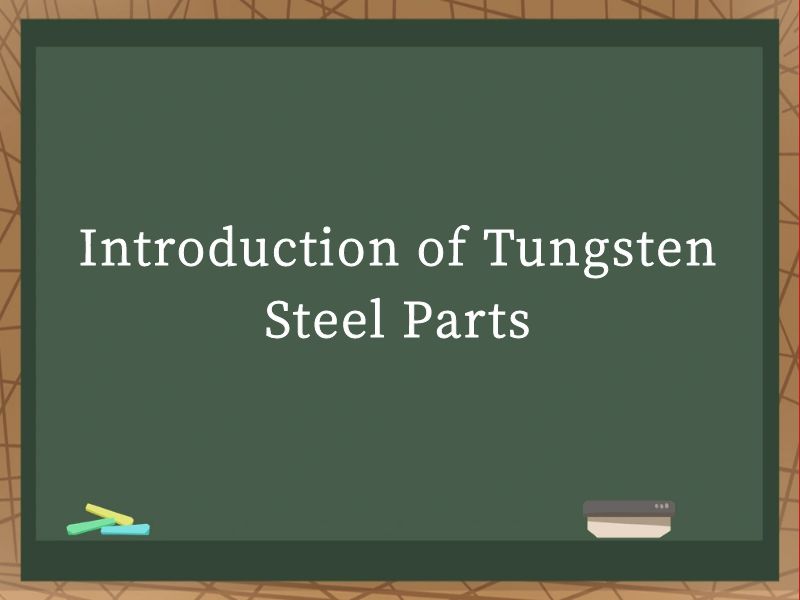JOURNALISM
- NEWS -
|
Introduction of Tungsten Steel PartsIntroduction of Tungsten Steel Parts.Tungsten steel parts have emerged as a cornerstone in the realm of industrial applications, distinguished by their exceptional properties that cater to a wide array of demands. This robust material, often referred to as high-speed steel (HSS) or tungsten carbide, encapsulates a blend of tungsten, carbon, and other alloying elements, resulting in a composition that is both versatile and resilient. The intricate interplay of these elements within tungsten steel parts grants them unparalleled characteristics, making them indispensable in various sectors such as manufacturing, tooling, and even aerospace.
The uniqueness of tungsten steel parts lies in their ability to withstand extreme conditions, be it high temperatures, heavy loads, or abrasive environments. This resilience stems from the high density and hardness of tungsten carbide, which forms the backbone of these parts. Tungsten, being one of the densest elements on Earth, contributes significantly to the material's mass and strength, while carbon enhances its hardness and wear resistance. The addition of cobalt or nickel binders further refines the microstructure, improving toughness and machinability. Manufacturing Processes The production of tungsten steel parts involves intricate manufacturing processes that ensure optimal performance and longevity. The journey begins with the careful selection of raw materials, which undergo rigorous quality checks to guarantee purity and consistency. Once verified, these materials are meticulously blended in precise proportions to achieve the desired alloy composition. The next critical step involves powder metallurgy, where the blended materials are converted into a fine powder. This powder is then consolidated under high pressure and temperature, typically through sintering, to form a solid, dense mass. The sintering process is pivotal as it facilitates the formation of strong bonds between the particles, enhancing the overall structural integrity of the parts. Subsequent to sintering, the parts undergo various machining operations to achieve the desired shape, size, and finish. This may include milling, grinding, drilling, and turning, each requiring precision and expertise to maintain the material's integrity. The final stage often involves heat treatment, which involves quenching and tempering to further enhance hardness, toughness, and dimensional stability. Properties and Applications The versatility of tungsten steel parts is evident in their diverse range of properties, each tailored to meet specific industrial requirements. Their exceptional hardness and wear resistance make them ideal for cutting tools, such as drills, milling cutters, and turning tools, where they can withstand the friction and heat generated during machining operations. The ability to retain sharpness over extended periods reduces the need for frequent tool replacements, thereby enhancing productivity and reducing costs. In the realm of mining and construction, tungsten steel parts excel in applications involving heavy-duty drilling and excavation. Their high density and strength enable them to penetrate through tough materials like rock and concrete with minimal wear and tear. This makes them indispensable in equipment such as rock drills, percussive drills, and tunnel boring machines. The aerospace industry also benefits from the unique properties of tungsten steel parts. In this sector, they are often used in components that require high thermal stability and resistance to extreme pressures. Examples include turbine blades, nozzles, and other critical engine parts, where their ability to maintain performance under harsh conditions is crucial. Moreover, tungsten steel parts find their way into the automotive industry, particularly in high-performance applications. In racing cars and sports vehicles, they are utilized in brake systems, gears, and other components that demand superior hardness and durability. Their lightweight yet robust nature contributes to improved fuel efficiency and overall vehicle performance. Customized Solutions The adaptability of tungsten steel parts extends beyond standardized products, offering customized solutions tailored to specific needs. Manufacturers leverage advanced design and manufacturing technologies to create parts that meet unique specifications, be it in terms of dimensions, geometry, or material composition. This customization ensures that the parts seamlessly integrate into existing systems, optimizing performance and reliability. The customization process often begins with a detailed consultation, where the manufacturer collaborates with clients to understand their specific requirements. This includes assessing the operating conditions, identifying potential challenges, and determining the optimal material composition and design. Once the requirements are clearly defined, the manufacturer utilizes computer-aided design (CAD) and computer-aided manufacturing (CAM) software to create precise digital models of the parts. These digital models are then translated into physical prototypes through advanced manufacturing techniques, such as additive manufacturing (3D printing) or precision machining. The prototypes undergo rigorous testing to validate their performance and durability, ensuring they meet or exceed expectations. Based on the test results, any necessary adjustments are made to the design, and the final production batch is manufactured. Environmental and Sustainability Considerations As industries strive towards sustainability, the environmental impact of tungsten steel parts has become a topic of concern. The extraction and processing of raw materials, particularly tungsten, involve energy-intensive processes that can have adverse effects on the environment. Therefore, manufacturers are increasingly adopting eco-friendly practices to minimize their carbon footprint. One such practice involves recycling tungsten carbide scraps and by-products. Through advanced recycling technologies, these scraps can be processed and reused, reducing the demand for new raw materials. This not only conserves natural resources but also cuts down on energy consumption and waste generation. Manufacturers are also exploring alternative materials and processes that offer similar performance characteristics but with a lower environmental impact. For instance, ceramic-based composites and advanced polymer materials are being investigated as potential substitutes for tungsten steel in certain applications. While these alternatives may not fully replicate the properties of tungsten steel, they offer viable options for reducing environmental harm. Future Trends and Innovations The future of tungsten steel parts is marked by ongoing innovations and technological advancements. Researchers are continuously exploring new alloy compositions and manufacturing processes to enhance the material's properties and broaden its application scope. One promising area of research involves the development of nanostructured tungsten carbide, which offers even higher hardness and wear resistance than traditional microstructured materials. Advancements in additive manufacturing are also poised to revolutionize the production of tungsten steel parts. By enabling complex geometries and intricate designs, additive manufacturing offers unprecedented flexibility in customization and prototyping. This technology can significantly reduce lead times and production costs, making tungsten steel parts more accessible to a wider range of industries. Furthermore, the integration of Internet of Things (IoT) and smart manufacturing technologies is expected to transform the production and maintenance of tungsten steel parts. Through real-time monitoring and predictive analytics, manufacturers can optimize production processes, reduce waste, and improve part performance over time. This digital transformation will not only enhance efficiency but also foster a more sustainable manufacturing ecosystem. In conclusion, tungsten steel parts stand as a testament to the ingenuity of materials science and engineering. Their exceptional properties and diverse applications have made them indispensable in various industries, driving productivity and innovation. As manufacturers continue to explore new materials, processes, and technologies, the future of tungsten steel parts looks promising, with endless possibilities for customization, sustainability, and performance enhancement. By embracing these advancements, industries can harness the full potential of tungsten steel parts, paving the way for a brighter, more efficient future. |


